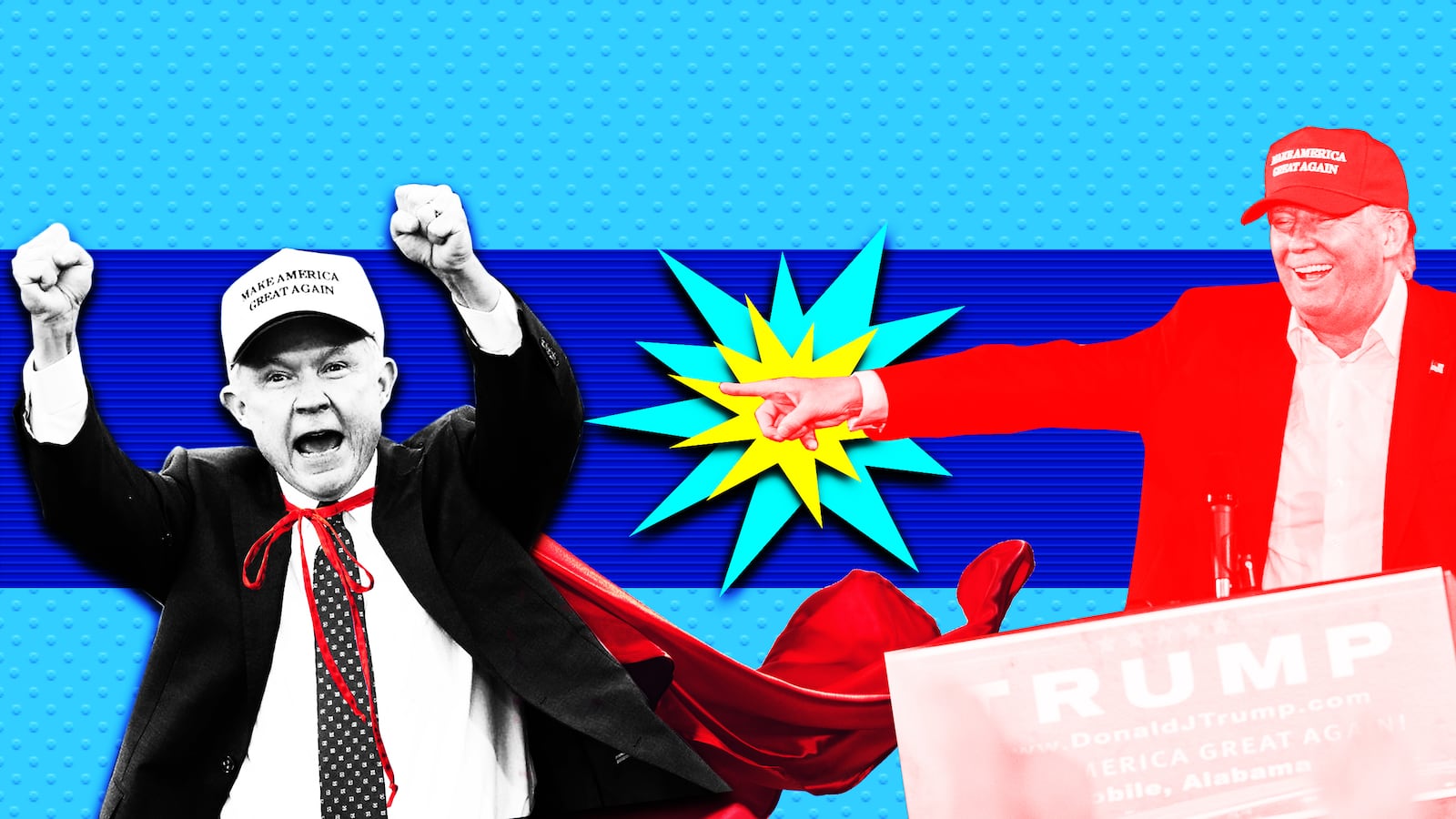Welcome to Rabbit Hole, a breaking news analysis that helps you get smart on the one story everyone’s obsessing over—for Beast Inside members only.
The day we all knew was coming has finally arrived: Donald Trump fired Jeff Sessions, ending the extended ritual humiliation of the attorney general whom the president never forgave for failing to put him above the law. But it wasn’t always thus. Long before Sessions was on the receiving end of Trump’s Twitter lashings, the two were anti-immigration crusaders and early allies. How did it all go so wrong?
Anti-immigration mind meld: What brought the two together? Immigration. Sessions staked out a position for himself in the senate as an immigration hawk even within the Republican caucus. When Republican leaders like Marco Rubio, John McCain, Jeff Flake, and Lindsey Graham formed the right flank of an immigration reform “Gang of Eight” in 2013 alongside senate Democratic heavyweights, it was Sessions who helped kill the nascent effort at a bipartisan bill. In 2014, he took the consolation prize of the Senate Judiciary Committee’s immigration subcommittee chairmanship and turned himself into the upper chamber’s leading anti-immigration hawk.
Trump launched his presidential campaign not long after in June 2015 and planted a flag as the most extreme anti-immigration candidate with racist comments declaring Mexicans “rapists.” Trump, according to the Washington Post, began a quiet courtship of Sessions that year and sought his input in developing the campaign’s immigration platform. By August of 2015, Sessions staffer and eventual Trump White House adviser Stephen Miller had joined the Trump campaign and Sessions was offering public praise for Trump’s vow to deport the so-called “Dreamers,” the children of undocumented migrants brought to the U.S. as children.
First: With Trump and Sessions drawing ever closer, they decided to make their relationship official in February of 2016 with a public endorsement from Sessions during a rally in Mobile, Alabama. In a statement, Sessions singled out immigration as a primary motivation for his support. “Trump alone has rejected the donor class, defending America's jobs and wages from open borders, uncontrolled immigration and the massive Trans-Pacific Partnership that will cede U.S. authority to foreign powers.”
The rally amounted to a coup for Trump. As the first sitting senator to endorse Trump, Sessions gave Trump crucial early establishment credibility at a time when he was till being shunned by mainstream conservatives. The endorsement also helped to Trump to mete out the first of many humiliations on Texas Senator Ted Cruz. Cruz, then Trump’s presidential rival, had been courting Sessions’s endorsement in a bid to make himself the most hard-line anti-immigration candidate.
Inflection point: At that point, it seemed as though Sessions could’ve been on a glide path to a relationship with Trump as smooth as any of those that the famously mercurial president enjoys with any of his senior staff. Cracking down on both legal and undocumented immigration has been the true north to which Trump's political and policy instincts have always returned and Sessions has been only too happy to serve his boss’s immigration instincts, like his announcement of the “zero tolerance” child separation policy for migrants arriving at the border. But the Russia inquiry and Sessions’s recusal from it would grow to poison the two men’s otherwise promising partnership.
Collision course: Beginning in July of 2016, Sessions unwittingly set in motion a series of events which would poison his relationship to Trump and lead to his unceremonious firing on Wednesday. During the Republican National Convention in Cleveland, Sessions met with Russian Ambassador Sergey Kislyak and had another conversation with him on the sidelines of a Heritage Foundation event in August. A month later, Sessions invited Kislyak to his Senate office for a more direct chat. Kislyak discussed the first two meetings, later leaked to the Washington Post by U.S. intelligence officials, with his bosses back in Moscow and told them he and Sessions discussed Trump’s thinking on important policy issues. Those moves placed Sessions at the center of the future Russia investigation and on a collision course with Trump.
Kislyak who? Trump returned the favor to his early endorser and announced Sessions as his attorney general nominee shortly after election day in 2016. Under questioning from then-Senator Al Franken about how he would handle the revelation of Trump staff communication with the Russian government during the campaign during his confirmation hearing, Sessions falsely denied having met with Russian officials. “I've been called a surrogate at a time or two during that campaign and I did not have communications with the Russians and I'm unable to comment on it,” he told Franken. In questions for the record submitted by Sen. Pat Leahy for the same hearing, Sessions again said he’d never been in contact with Russian officials “about the 2016 election.”
Denouement: The last straw in Trump and Session’s relationship came about when the Washington Post revealed Sessions’s meetings with Kislyak and the fact that he hadn’t told the truth in his confirmation hearings. The attorney general had already been facing calls to recuse himself based on his role in the campaign but the mounting pressure forced him to step aside and recuse himself from what was then simply an FBI investigation.
That move, however, was against the advice of both Trump and his advisers. Sessions was already on the receiving end of private barbs from the president, who reportedly called his nominee “mentally retarded” for his confirmation hearing performance. Asked if he thought Sessions should recuse himself, Trump told reporters “I don’t think so” and tweeted that he was an “honest man” who “did not say anything wrong.” Behind the scenes, he was more emphatic. The New York Times later revealed that Trump had directed his then White House counsel Don McGahn to stop Sessions recusing himself and fumed “Where is my Roy Cohn?” when the effort failed.
All downhill: Trump’s final effort to get the Russia investigation in hand—firing FBI director James Comey—blew up in his face when it prompted the appointment of the hard-charging Robert Mueller as Special Counsel. With a dogged prosecutor on his tail and no levers to steer the investigation, all Trump could do was pout and take out his fury publicly on Sessions, both in interviews and tweets. With the midterms over and Republicans’ grip on the senate strengthened, Trump was finally in a position to fire the object of his ire secure in the knowledge that he could get a replacement through the Senate.






